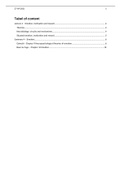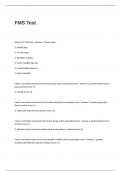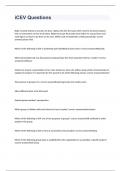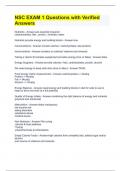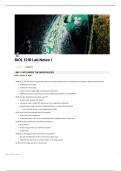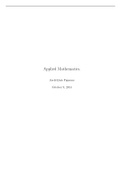Tabel of content
Lecture 4 – Emotion, motivation and reward.........................................................................................2
Theories..............................................................................................................................................2
Neurobiology: circuits and mechanisms.............................................................................................4
Situated emotion, motivation and reward.........................................................................................5
Summary 4 – Emotion............................................................................................................................6
Gainotti – Chapter 9 Neuropsychological theories of emotion...........................................................6
Baars & Cage – Chapter 13 Emotion.................................................................................................10
,27-09-2021 2
Lecture 4 – Emotion, motivation and reward
Theories
What are emotions?
One way to define emotion is by there time scale. Episodic nature: relatively short timescale.
It generally includes 3 components: physiological arousal, expression and a subjective feeling (most noticeable
to yourself). It possibly includes cognitive evaluation.
There are some triggering events. This could be external (conditioned/learned) or internal (cognitive
appraisal/interpretation of an event). It must be salient to trigger an emotion.
Emotions van motivate and affect behaviour.
Historical context: thinking about emotion
Early theories:
Plato and Aristotle
Contrasting the idea of separate or integrated systems for emotion, cognition and motivation
Descartes
Passions communicated through bodily fluids that interface between body and mind
Embodied perspective body influences mind
Darwin
Biology vs. culture (nature/nurture). What comes from your surroundings/what from the genetics.
Model types of emotion
Components: Physiological, subjective, expression, cognitive appraisal
˃ James-Lange theory: physiology drives other processes. Bodily change, leads to cognitive awareness,
leads to subjective sense and expression of emotion.
˃ Cannon: cognitions drive other processes. Evaluation leads to a physiological response and
expression.
˃ Strack et al.: expression drives other processes: controversial. Acting a certain way, leads to other
processes.
Overarching dimensions: our emotional states can be reduced to a small number of dimensions that
describe the full spectrum of our emotional well-being
˃ Valence: positive/negative coloring of emotions pleasure
˃ Arousal: activity level, sleepy to hyper-energetic
˃ Dominance or relaxation/attention: lesser used, add depth to 2-factor model
Discrete systems, categorical approach
˃ Small set of basic emotions
˃ Individual mechanisms for specific states
, 27-09-2021 3
Dimensional model (Russel): we have different emotions organized. Two-dimensional space for all emotions.
Does not account for complex emotion. Dominance
dimension may better distinguish anger and fear.
Relaxation-attention dimension allows more definition in
subjective experience range.
Basic emotions differ per theorist, because of different criteria use. Bases for inclusion: relation to action
readiness/motivation, hardwired or unlearned, universality between cultures, separability in brain signals.
Panksepp initially suggests that the basic emotions are expectancy, fear, rage and panic. He later expands this
with lust, care and play. He is taking a comparative approach over all animals and humans.
Comparative perspective:
Survival advantage of various emotions (documented by Darwin)
Emotions are hardwired in mammalian brain. Parallel systems in all mammals
Increasing knowledge on complex emotional processing in non-human animals (also non-mammals)
˃ Conditioned optimism/pessimism (learned helplessness )
˃ Neural measures
˃ Vocalizations
Implications for ethical treatment of animals
Core concepts: motivation and reward
Classical notion of motivation: maintaining homeostasis by food and fluid intake and temperature regulation.
Recently, people have focused more on behavioural drive/reason to act: informed by survival needs, some kind
of predicted reward, emotions or instinct to explore.
Reward: pleasure response
This is the mechanism of reinforcement and learning of behaviour that is needed for survival
Negative reinforcement: reversive stimulus minimizing contact with harmful stimuli.
Reward functions as a motivator: incentive salience (wanting to do something again).
Wanting, desire, anticipation
Pleasure cycle: appetitive, consummatory, satiety
Models of motivation and needs
Homeostasis: maintaining physiological balance within a certain range:
Food; cycle of nutrient intake, digestion and satiety signal adjustment. Disruption of this system or failure
of behaviourally respond to satiety signals can lead to eating disorders or obesity.
similar for other bodily functions
Psychological models:
Maslow: hierarchy of needs

